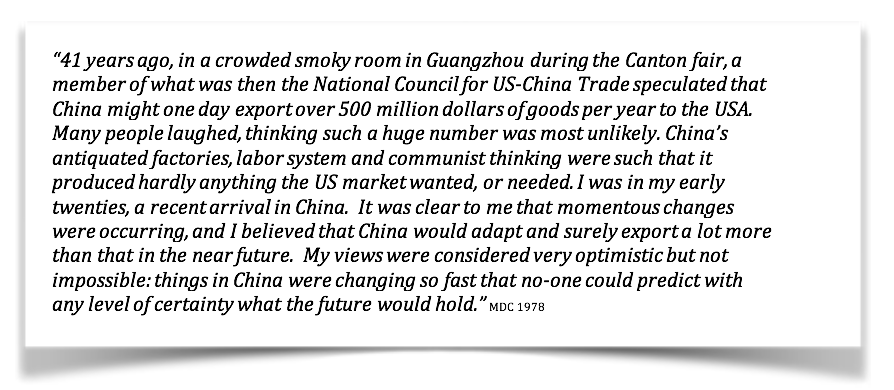Reflections on 40 Years of China Sourcing
May 12, 2023

Editor’s Note: This blog was originally published in 2018
1978-2018
As our 40th anniversary year comes to an end, I look back at our business, how it came about, why we did it, and what it means today.
People often ask me how CPG got started, and more specifically, why I learned Chinese way back when China was not yet open for business. My answer: curiosity and luck. Curiosity because I found the language fascinating, so different in structure from our own. This encouraged me to study classical Chinese, as well as Chinese philosophy and history. Luck, because Chinese was clearly not a practical tool for a budding businessman, I studied it despite that. I had no plans, no vision to use it in the future. But as events unfolded, fluency in Mandarin turned out to be a valuable asset.
I first traveled to China in 1975, when I was 21. I had a broken leg and so I hobbled across the border on crutches. For months, I visited Guangzhou, traveled by train to Beijing, I even went to the Northeast and traveled to Mongolia. I was witnessing an awakening and this was the beginning of an adventure: I never suspected it would last this long.
I came back in 1978 to set up my own company and I opened an office in Beijing. My first, urgent and paramount concern was money. I did not have much and banks at that time, as you can imagine, were unwilling to lend funds to a China-based business. I needed cash flow. I figured the best way to get that was to export Chinese merchandise to the USA.
So I became an early buyer of Chinese consumer goods and re-sold them to US companies. Easy to say, harder to do. My first challenge was to find buyers, but my second was even harder: deliver the promised goods.
Buying at the right price was one step, making sure the quality met our requirements was another, and shipping on time was a third. During the early years, ensuring performance on all fronts was a steep learning curve.
China became my arena, the place I learned to do business. And learn I did. A lot. Fast. Getting things right was an existential imperative. So every time I came across a problem, I had to find a solution. And I wrote it down. As I built a supporting team, these solutions evolved into procedures, and these in turn were always improved. They were used for training and provided an early management foundation upon which we grew.
We made mistakes, we fixed them, we learned, and we grew. The news about sourcing from China spread, and by the early 1980’s many importers were “discovering” China. It was the place for pioneers to be. The quality of basic goods was quite good, and prices were much better than in South Korea and Taiwan.
But this growing awareness created competition and put pressure on our margins. We could no longer compete as a trader, so we pivoted and told our clients that, instead of selling to them, we would help them buy instead.
Suddenly we became a service provider in a country where service was sorely needed. The sourcing procedures and management systems we had developed to protect our own were used to grow the business of our clients.

Fast forward to today and we find that our China-sourcing world has changed in many different and fundamental ways., making it nearly unrecognizable.
The phenomenal growth of China as a supply center for the world has been told exhaustively and does not need to be repeated here. But some data provide a useful perspective. China’s exports to the USA went from about $100 million when we started in 1978 (China had a trade deficit that year with the USA of about $600m) to $446 billion in 2018. During those 40 years, many milestone events affected China’s trade relations with the USA. Some of these are outlined in the chart below.
Moreover, most of China’s exporters are no longer state enterprises but are instead private companies. This has changed the dynamics of China supply chain management. China is no longer “China Inc.,” a monolithic single-state entity run by Foreign Trade Corporations. It has become, instead, a complex and uneven amalgam of private enterprises driven by profit and supported by a young system of laws and regulations.
“Made in China”, which in the past often meant “poorly made,” has become a quality label attached to products like iPhones, cars, and fancy drones.

Technology, especially the internet, has changed the way we buy today, both as individuals and as companies. It has disrupted the world of distribution and retailing and has enabled the rise of giants like Alibaba and Amazon. In its many forms, such as AI (Artificial Intelligence) and the blockchain, technology is likely to continue to profoundly change the way we do things.
And yet, in 40 years of China sourcing, the simple, the obvious and the essential has remained constant: people.
At one end of the supply chain you have the buyers. They have changed over time of course, but in the early days only the savvy, the experienced “Far-East” buyers dared to venture into China. Today the field is broader: buyers include the entrepreneurs trying to develop new ideas, the small business owners struggling to maintain an edge in a changing marketplace, the corporate purchasing manager who seeks efficiency and excellence.
On the other end, you have the suppliers. Today they are the owners of factories who have invested in real estate and machinery, and also those of trading companies who specialize in certain product categories, etc.
What unites buyers and suppliers are the commercial benefits—the financial gains of their interaction. What often separates them is culture and the language. In 40 years, this has not changed much. Suppliers are overwhelmingly Chinese, and most buyers tend to be Western.
The image of a supply “chain” has endured because it conveys both the simplicity of its concept and the complexity of its execution. The three key elements of pricing, quality, and delivery are interconnected links that must be balanced. A chain is only as strong as its weakest link, and preventing weakness is the constant struggle of the supply chain manager.
Technical innovations, the internet, robotics, AI, and better algorithms, all have made supply chain management in China more productive and more efficient. It is technology that has opened the door to many more players and has improved the checks and balances process. But it still is human endeavor that drives the chain, it is people who solve problems and get results.
The trillions of dollars of new trade that occurred between China and the world since 1978 is a testimony of the success of that human endeavor, the proof that these people had the ability to work together. To succeed they sought excellence in every aspect of the chain; they developed skills to overcome challenges and they built trust and understanding.
In my analysis, the most important of these people skills were:
- Communications: Clear, predictable, reliable.
- Understanding: The why, the needs, the goals. Defining the mission.
- Execution: On time, on budget. Attention to details.
- Management: The people, the processes, the systems.
These skills have endured and they are still essential today. Observe very successful buyers, those who have developed and grown profitable sourcing operations and you will find they are supported by robust operations that still value and master the above.
No wonder then that, looking back over the 40 years of our adventure, what stands out are the people. We were fortunate to have found a people-based formula to support our clients and strengthen the control of their China supply chain management. And we were blessed to have the specialists who developed the unique, low-cost team approach our clients needed.
So, on this anniversary year, I salute our employees for their heart, their creativity, their dedication, and their passion. They are the reason for our success and they will be the drivers of our growth in this fascinating, challenging, and rapidly changing environment. I hail our clients, all of them leaders with vision who advanced their business objectives by tapping into a global supply chain. And I give tribute to the suppliers, the best among whom became successful by delivering on their promises again and again.
In conclusion, when I look back at the last 40 years and ask myself what made us successful, three factors stand out: luck, people, and processes. Learning Mandarin when I did was especially lucky, because language is such a strong enabler. The people were key, those who formed and informed me, those who supported and believed. And finally, the processes: the last four decades were turbulent, rapidly changing times, distractions were many, focus was hard. Yet success depended on the stubborn execution of a vision and execution depended on organization, and we all know that organization in turn always requires clear processes.
What will the next 40 years look like? This question is the cause of endless and fascinating speculations. It is obvious that changes during the next 40 years will not slow down, they will be even more significant than those that occurred in the previous 40. But one thing is clear to me, the future will be built on the foundation of the hard work of vastly different people striving towards a mutual benefit. That is a future I can get excited about.
Editor’s Note: This blog was originally published in April 2019.

